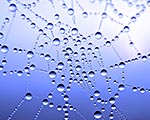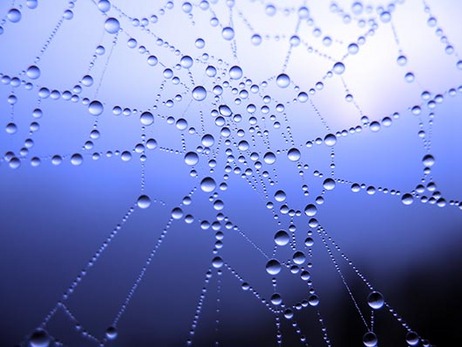« Innovation in Business Story
New Materials Inspired by Water-Catching Properties of Spider Webs
Breakthrough:A new study into how spider webs are able to catch water from the air could speed up the development of manmade materials that capture atmospheric moisture. These could be used to provide water to drought-stricken areas.
Business:
Chinese Academy of Sciences, China
The Story:
 Based on their research Lei Jiang and colleagues at the Chinese Academy of Sciences in Beijing created an artificial silk that mimics the water collecting abilities of natural webs.
Based on their research Lei Jiang and colleagues at the Chinese Academy of Sciences in Beijing created an artificial silk that mimics the water collecting abilities of natural webs. Whilst much is known about the strength of webs the scientists were keen to probe the lesser known ability of spider silk to capture and hold onto rain and morning dew – a mechanism that saves a spider from having to find a water source.
Caught in the Web
Using a powerful scanning electron microscope and a light microscope the team studied how the spider silk changes its structure when it becomes soaked in water vapor.
At the nanoscale dry spider silk resembles a necklace-like structure. It is formed from hydrophilic knots of silk connected by smooth and slender stretches known as joints. When water condenses on these knots they shrink into densely packed structures that are shaped like spindles.
Moist droplets that hang from the spaces in between are drawn toward their nearest spindle-knot, where they gather in larger droplets. The difference in texture between the rough knots and the smooth joints aids the water movement.
“As anyone who has admired spider webs adorned with dew drops will appreciate, spider silk is also capable of efficiently collecting water from air. Here we show that the water-collecting ability of the capture silk of the cribellate spider Uloborus walckenaerius (a common non-venomous spider) is the result of a unique fiber structure that forms after wetting,” Jiang wrote in the science journal Nature.
Mimicking Nature
Following this research Jiang’s team fabricated fibers that copied these properties. To do this artificial silks were formed by coating nylon fibers with poly(methylmethacrylate)/N,N-dimethylformamide-ethanol, which dries in tiny knots just like those in real spider silk. “Our artificial spider silk not only mimics the structure of wet-rebuilt spider silk but also its directional water collection capability,” the scientists claim.
The new material could be used to upgrade fog-catching nets such as those deployed in the coastal Andes that are providing people with water that they otherwise don't have access to. If the technology is commercialized it could be of great to benefit to communities living in rain-starved areas of the world.
Further Applications
And there could be further uses. Spider silk has a number of properties that are not found in manmade materials. Experts believe that if we can learn how to match these properties a range of new materials with superior mechanical properties could be developed for an enormous range of applications.
Jiang and his team plan to continue with their studies to untangle more knowledge about the water retention properties of spider webs. They are also considering developing a set of novel materials that are able to control water in different ways. They believe that one application of this could be so-called “smart catalysis” which can increase the speed of a chemical reaction without actually using a catalyst.
Next Story »
IdeaConnection: What Can we Solve for You?

